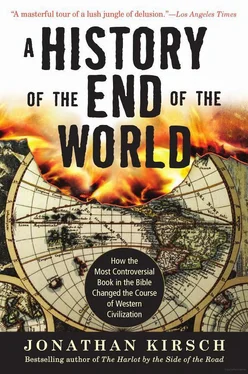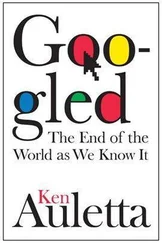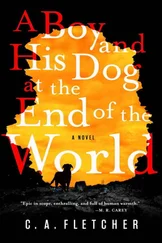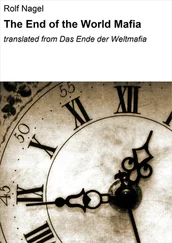The seven ages of history have been used to solve some of the more perplexing mysteries within the text of Revelation. John, for example, explains that the seven heads of the beast from the sea are meant to symbolize seven kings, but he does not specify which ones. Some early readers studied The Twelve Caesars of the ancient historian Suetonius in the hope of putting names on the seven heads. One faction starts with Julius Caesar and counts the first seven emperors in strict order of succession, and another faction leaves out the more obscure ones like Otho and Vitellius and counts only the most celebrated or notorious Roman emperors. But theologians of late antiquity and the early Middle Ages preferred to see the seven-headed beast of Revelation as a symbol of the seven ages of history, and they thrilled at the notion that they were living in the seventh and final age.
None of these theories, however, and nothing in Revelation itself, suggests that the world will end in a year that ends in three zeroes. The only significance of the millennium in the book of Revelation is the duration of Christ’s earthly kingdom and the period of Satan’s imprisonment in the bottomless pit. John seems to allow that the millennium might start in any year of the calendar. Thus, for example, a Spanish monk called Beatus of Liébana, writing around the year 775, confidently predicted that the Sabbath Age would begin sometime in the year 800—but he cagily downplays the significance of the precise date.
“Every catholic ought to ponder, wait and fear, and to consider these twenty-five years, as if they were not more than an hour, and should weep day and night in sackcloth and ashes for their destruction and the world’s,” writes Beatus in his thousand-page commentary on Revelation, “but not strive to calculate time.” 99
Far more important than the number of zeroes in any given year on the calendar were the signs and wonders that John warns his readers to expect when the end-times approach. The breaking of the seven seals, the pouring of the seven vials, and the sounding of the seven trumpets are all said to signify plague and pestilence, famine and war, earthquake and eclipse, and even stranger phenomena of nature: “And I beheld when he had opened the sixth seal, and, lo, the sun became black as sackcloth of hair, and the moon became as blood,” writes John, “and the stars of heaven fell unto earth, and every mountain and island were moved out of their places.” For the watchful Christians of the Middle Ages, then, anything even slightly out of the ordinary—a calf born with a birth defect, a seismic tremor, or a shooting star—might turn out to be a welcome sign of the end-times.
“Alpha and Omega. The beginning and the End,” are the words of an inscription from Poitiers in the seventh century. “For all things become every day worse, for the end is drawing near.” 100
Even the most commonplace sights on the landscape of medieval Europe, in fact, were also freighted with apocalyptic meanings for Christians who lived in anticipation of the end-times. And, prompted by the book of Revelation to watch for the signs of the Antichrist, they let their eyes fall on the men and women among them whom John so hatefully characterizes as members of “the synagogue of Satan.” Thus did the Jews earn a crucial role in the apocalyptic drama that came to dominate the Christian imagination in the Middle Ages.
Here is yet another dark and dangerous irony. Christianity started as a sect within Judaism. Jesus, the twelve disciples, and all of the first Christians were Jews by birth, of course, and the author of Revelation, too, proudly claims to be an authentic Jew. But Revelation clearly shows the theological fault line along which the two faiths split asunder in the early history of the Christian church. The first Christians, after all, were Jews who saw Jesus of Nazareth as the Messiah, but they were not content with distancing themselves from their fellow Jews who refused to do the same. Following the example of Revelation, the Jews were not merely condemned but demonized, too.
Bishop Hippolytus, writing in the third century, was among the earliest Christian propagandists to characterize the Beast of Revelation as both satanic and Jewish: the Antichrist, he insists, will be a descendant of the biblical tribe of Dan, and he will recruit his demonic army from Jewish communities throughout the world. By linking the Antichrist with the tribe of Dan, Hippolytus is offering an intriguing solution to one of the most obscure mysteries of the book of Revelation. John includes a list of the twelve tribes of ancient Israel, but he pointedly omits the biblical tribe of Dan. Perhaps John leaves Dan off the list because he has been granted an undisclosed revelation that the Antichrist will carry that tribe’s blood in his veins, or so the early church fathers speculated.
By the fourth century, the depiction of the Antichrist in religious propaganda was even more elaborate—and even more specifically anti-Semitic. Martin of Tours, for example, warned that when the Antichrist finally reveals himself to the world, he will seat himself on a throne in the city of Jerusalem, rebuild the Temple of Solomon, and compel the universal practice of circumcision. And, according to the lascivious details that were added to the profile of the Antichrist in Christian legend and lore, he will be conceived in a Babylonian brothel, the child of the Devil and a Jewish whore; he will be circumcised in Jerusalem, where he will declare himself to be the Messiah; and he will die when he attempts to ascend to heaven from the Mount of Olives but falls into the depths of hell.
The book of Revelation itself, of course, is more restrained. Aside from John’s passing reference to “the synagogue of Satan,” however hateful it may strike us today, the rest of the text is wholly free of crude anti-Semitism. Indeed, as we have seen, John considers himself an authentic and faithful Jew, and he is deeply attached to Jewish history, ritual, and symbolism. At the only moment in the book of Revelation when he depicts himself as actually participating in a visionary event, for example, John is handed a golden measuring rod by an angel and ordered to survey the celestial Jerusalem in all of its particulars. John pauses in his otherwise wild-eyed and blood-shaking tract to note in meticulous detail that boundaries of the holy city are exactly twelve thousand furlongs (or fifteen hundred miles) in length on each of its four sides. 101By contrast, Jesus is shown in the Gospel of John to declare that the Temple at Jerusalem will be destroyed and replaced by “the temple of his own body.” 102
Above all, John betrays his Jewish roots when he envisions the thousand-year reign of Jesus Christ. Indeed, it is exactly here that we see the fundamental difference between Judaism and Christianity when it comes to the idea of the Messiah. The Jewish redeemer is imagined to be a flesh-and-blood human being whom God will send to bring security and sovereignty to the Jewish people down here on earth, an era that will last between forty and four hundred years according to some Jewish apocalyptic writings. By contrast, the Christian messiah is the Son of God, and he will reign eternally in heaven after the world has come to a final end. John seems to want it both ways in the book of Revelation: he predicts that Jesus will reign as king on earth in a restored Jerusalem for exactly one thousand years, and then the earthly kingdom of saints and martyrs will be replaced by a celestial one for the rest of eternity.
John is the only author in all of the Christian scriptures who plainly describes Jesus as an earthly king whose reign can be measured in real time. That’s one reason why Revelation has been characterized by some scholars as “subchristian or not even Christian.” 103And, in fact, John’s awkward embrace of the Jewish messianic idea provided a rhetorical weapon for Christian theologians like Jerome and Augustine who insisted on a “spiritual” rather than a “carnal” reading of Revelation. Only the Jews imagined a messianic kingdom like the one described in Revelation, and Christians must read and understand John’s text symbolically rather than literally: the thousand-year reign of Christ on earth as depicted in Revelation represents the authority of the church rather than a prediction that Jesus will actually float down from heaven and seat himself on a throne in the city of Jerusalem.
Читать дальше










